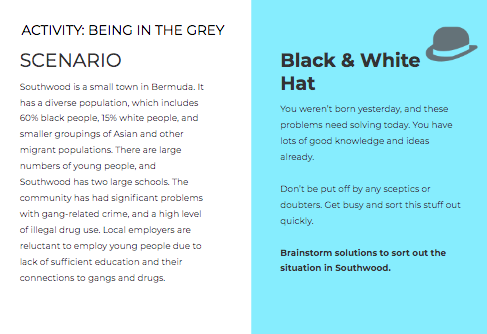Mindset 5: Being in the grey
To be in the grey is to be comfortable with ambiguity and uncertainty, so that we are open to new ideas. Rather than presuming that problems are clear cut and the solutions are obvious, it’s accepting that we live in a complex, uncertain world.
When trying to tackle a complex problem, sometimes we can feel overwhelmed by the unknown and frustrated by how long it can take to see change. We also sometimes look for ‘silver bullet’ solutions, leading to leaping to conclusions and reaching for old, familiar solutions for a sense of predictability and control. Instead, we need to dive freely into the grey space by asking big, fundamental questions and exploring new possibilities.
Being in the grey requires us to:
Simmer in uncertainty
It’s natural to crave a sense of predictability and control – yet it’s dangerous to assume we know all we need to know and can see into the future. Instead of fearing the unknown and unpredictable, become familiar and comfortable with it.
Play, test, learn
We must embrace exploration, and surround ourselves with possibilities to ask questions - what better way than through playing, testing and learning continuously.
Step outside our comfort zone
To do this, we can bring in creative thinkers from outside our sector to provoke us with new questions, suggest challenging ideas, and provide new ways of framing old problems. Instead of letting their lack of knowledge in a particular area hold them back, they thrive in the grey by looking at things differently and widening our view on a challenge.
Exercise
This exercise is best done in a small team of at least four people. While it would be great if you can connect with colleagues to try this out (face to face or over a video chat platform), we know that isn’t always possible. Instead you could ask a family member or friend if they would like to join you - they don’t require any pre-existing knowledge, just a willingness to have a go.
Step-by-step guide:
Break into two teams and divide the tool so that one team has the ‘black and white hat’ page and the other team has the ‘grey hat’ page below (you can click on the images to download and print a PDF).
Teams read the scenario shared on the tool (which is the same on both pages), and the challenge each page sets (which is slightly different).
Each team has 10 minutes to discuss the scenario and work on the challenge their page sets for the team.
Next, come back together as a group. The ‘black and white hat’ team shares the challenge they were set and the solutions they arrived at. The ‘grey hat’ team then shares their challenge and the questions they created.
Reflect as a group: what do you notice that was different about the positions both teams arrived at? How did the process feel for both teams? Could the solutions arrived at by the black and white hat team have benefitted from finding answers to the questions posed by the grey hat team? You can share on Twitter using #LearningFirstBDA too.
SUGGESTED TIME:
20 minutesLEVEL OF DIFFICULTY:
MediumMATERIALS NEEDED:
The 'hats' toolPARTICIPANTS:
You will need at least four people for this exercise, and break up into two teams

